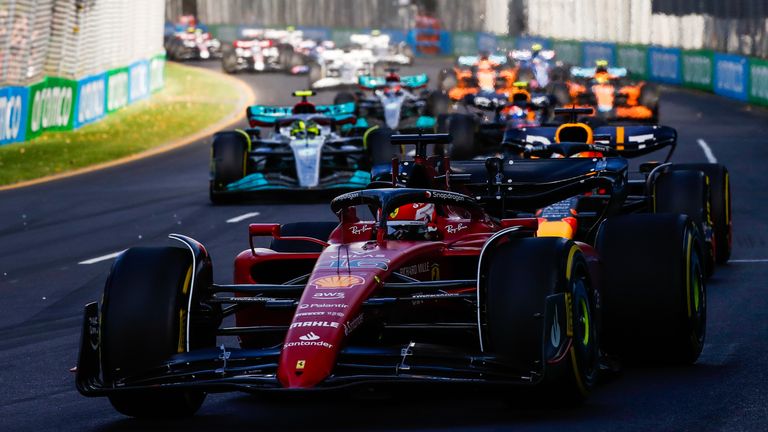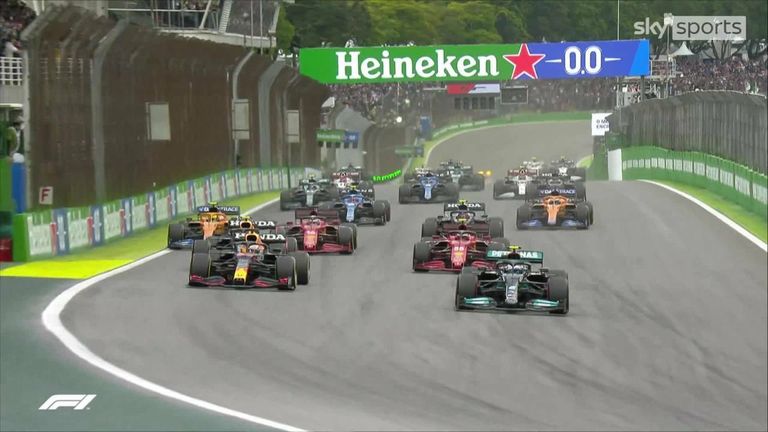Sprint: Explaining F1’s returning format and why it’s more significant ahead of Emilia Romagna GP

After three entertaining and incident-packed Sprint weekends last year, the format returns at Imola for the Emilia Romagna GP. But what are the benefits of the Sprint, what’s happened so far, and what’s new?
Ahead of this weekend’s action – all live on Sky Sports F1 – we answer some of the key questions about a format that is set to bring even more excitement to 2022.
What exactly is the Sprint?
The Sprint is the name of the shortened Saturday race that debuted in 2021 and is back for 2022, shaking up the usual weekend format and providing more wheel-to-wheel action with another race.
Effectively a mini version of what we see on Sundays, drivers race over 100km – which is a third of the usual race distance and in Imola’s case converts to 21 laps – in a flat-out sprint for grid slots for the Grand Prix and points for their championship hopes.
Replacing qualifying in the Saturday slot, we’ll see the Sprint at three more rounds in 2022, starting this weekend. It starts at 3.30pm and is live on Sky Sports F1 and Main Event, with build-up from 2.30pm.

Max Verstappen loses two places on the opening lap of the Sprint at the Sao Paulo GP
How does it work?
The 20 drivers start in the order they qualified on Friday evening – more on that below – and their finishing positions 100km later will be the positions they line up in for the start of Sunday’s Grand Prix.
If you win, you’re starting Sunday’s race from pole position; if you’re 10th, you start in that same spot one day later, while if you hit technical trouble or crash out, you’ll be at the back and left with it all to do.
Are there points for the Sprint?
Yes – and significantly more than last year in one of the key changes.
In 2021, only the top three drivers scored points and there were only a total of six points on offer; three for the winner, two for second and one for third.
In 2022, the top eight will score points and that points total rises to 36. The winner will collect eight points, second place will score seven, with this continuing in descending order down to eighth (one point).
The points on offer means the Sprint is even more important in 2022.
Not only do more drivers – on top of battling for grid position for Sunday’s race – have a chance of points, but they can now take a total of 34 points over a weekend instead of the usual 26. Plus, if a driver wins all three Sprints in 2022, that almost adds up to a race win on its own (24). Handy.
What’s happened in the Sprint so far?
The Sprint had its critics before debuting in 2021 in Silverstone, Monza and Interlagos – but nobody can dispute that the new format provided entertainment to the weekends. Max Verstappen won the British GP opener after beating Lewis Hamilton off the line, before Valtteri Bottas won both the Italian and Brazilian GP Sprints for Mercedes, the latter featuring an incredible charge through the field from Hamilton.

Lewis Hamilton’s slow start enabled Max Verstappen to take the lead on the first lap at the British Grand Prix
While not responsible for controversy directly, the Sprint also had its part to play in hugely dramatic moments last year. At Silverstone, Verstappen getting ahead of Hamilton in the Sprint led to the pair clashing on the first lap in Sunday’s race. Again at Monza, the pair collided a day after the Sprint.
In Interlagos, meanwhile, Hamilton’s comeback driver resulted in the title rivals going wheel-to-wheel again on Sunday, with Verstappen escaping a penalty for his driving and Hamilton winning to reignite his championship.
What happens to Qualifying?
The usual three-part knockout qualifying hour still takes place, but is moved from its usual Saturday afternoon slot to Friday evening.
At Imola this takes place at 4pm BST.
The session progresses through Q1, Q2 and Q3 as normal to find the fastest driver and determine the 1-20 order for the Sprint, which then in turn – as mentioned above – sets the grid for Sunday’s race.

Ferrari ambassador Marc Gene gives his views on the challenges the Imola track will bring ahead of the Emilia-Romagna GP this Sunday
How many practice sessions are there?
There are only two practice sessions this weekend, one fewer than normal, each running to one hour in length as is now the case in F1 from this year.
Practice One starts on Friday at 12.30pm, with Practice Two at 11.30am on Saturday ahead of the sprint.
What else is new?
On top of the extra points, there is also a pole position clarification for the 2022 Sprint events after complaints from drivers.
Last year, the winner of the Sprint race was awarded pole for the record books, but there is a tweak for 2022 – with pole now being credited to the driver who sets the fastest time in qualifying, as is usually the case on a weekend.
However, the driver who wins the Sprint will start Sunday’s main Grand Prix from first, IE pole position.
So the winner of qualifying ‘gets’ pole, and the winner of the Sprint starts on pole for the race. Got it?
Are there pit stops in the Sprint?
Although not technically banned, pit stops are few and far between given how short a Sprint is.
Unlike the Grand Prix, there is no mandatory change of tyres required and, unless cars hit damage or puncture or it rains, don’t expect them to leave the action on track for the pit lane between lights out and the chequered flag.
Drivers are free to run on whatever tyre compound – hard, medium or soft – that they wish.

Lewis Hamilton was left pleased with Mercedes’ progress over the weekend, with himself and George Russell finishing fourth and third respectively
And the Grand Prix, is that unchanged on Sunday?
The 63 laps of the Emilia Romagna Grand Prix around Imola are unchanged and are still the main event for the weekend.
Lights out this year is at 2pm. Sky F1 build-up starts at 12.30pm.
The usual points apply for race day, that’s 25 for the victory (or a maximum of 26 if the winner nabs the fastest lap too) down to one point for 10th place.
The only difference is that drivers who start in the top 10 are not locked into starting on the tyre they set their best time in Q2 on. Everyone therefore has a free choice throughout the race, although the usual two-compound rules apply in a dry race which guarantees at least one pit stop per car.
No changes otherwise.
Where else will Sprint weekends take place in 2022?
Austria’s Red Bull Ring will next host the Sprint weekend on July 8-10, before the format returns to Interlagos on November 9-11, with three rounds again playing host to the Sprint.
F1 had hoped to double the amount of Sprints to six for 2022, but had to settle for a compromise after several of the top teams complained over cost issues amid the budget cap.
Depending on the success this year, expect the Sprint format to feature more heavily on calendars in the future.

Pingback: Cambodian Magic Mushrooms store online,
Pingback: click the up coming post
Pingback: https://www.timesunion.com/marketplace/article/phenq-reviews-17525542.php
Pingback: superkaya slot login
Pingback: Belcampo Anya Fernald scandal
Pingback: Water Heater Plumbers
Pingback: แผ่นปูทางเดิน
Pingback: Graphics
Pingback: fruit cocktail casino
Pingback: grip770.com
Pingback: Finalshell